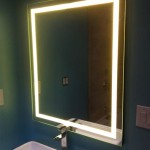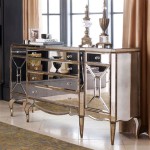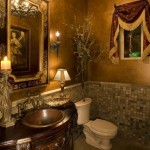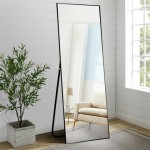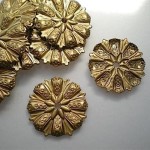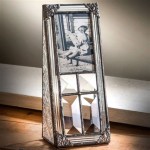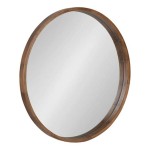Mercury Glass Effect on Mirror
The "mercury glass" effect, often sought after for its antique, slightly distressed appearance, can be applied to mirrors to create a unique decorative piece. This effect mimics the look of antique mirrors where the silvering on the back has begun to deteriorate, revealing patches of clear glass and a mottled, reflective surface. Achieving this look on a modern mirror involves various techniques, each with its own advantages and disadvantages.
One popular method involves using specialized spray paints formulated to replicate the appearance of aged mercury glass. These paints typically contain a mixture of metallic particles, often silver or a combination of silver and other metallic tones, suspended in a translucent base. The translucency allows some of the underlying mirror surface to show through, creating the desired aged effect. Several thin coats are typically applied, allowing each coat to dry before applying the next, to build up the desired opacity and texture. This method is relatively simple and accessible for DIY enthusiasts.
Another approach utilizes a chemical reaction to create the mercury glass effect. This involves applying a solution containing chemicals like stannous chloride to the mirror surface. The solution reacts with the silvering on the back of the mirror, causing it to oxidize and create the characteristic mottled appearance. This method offers a more authentic look, as the effect is created through a genuine chemical alteration of the mirror's reflective surface. However, it requires careful handling of potentially hazardous chemicals and precise application to achieve the desired results. It is generally recommended for experienced crafters or professionals due to the complexity and safety considerations involved.
A third method involves applying a layer of reflective material, such as silver leaf or a specialized mirroring film, to the back of a clear piece of glass. This material is then intentionally distressed or aged using techniques like rubbing with sandpaper or applying a patina solution. This method allows for greater control over the specific areas of distress and the overall look of the finished product. It also offers the flexibility to use different types of glass, including textured or colored glass, as the base. However, this approach requires more materials and specialized tools compared to the spray paint method.
Regardless of the method chosen, proper surface preparation is essential for achieving a successful mercury glass effect on a mirror. The mirror surface must be thoroughly cleaned and degreased to ensure proper adhesion of the applied materials. Any dust or debris can interfere with the even application of paint or chemicals, resulting in an uneven or flawed finish. In some cases, a primer may be necessary to enhance adhesion, particularly when using spray paint on a smooth glass surface.
The application technique also plays a crucial role in the final appearance of the mercury glass effect. When using spray paint, applying thin, even coats is key to preventing drips and achieving a smooth, consistent finish. For chemical applications, precise and controlled application is critical to achieving the desired level of distress and avoiding over-oxidation. When using silver leaf or mirroring film, careful handling and application are necessary to prevent wrinkles or tears in the material.
The desired level of distress or aging can be controlled through various techniques. For instance, using a damp cloth to dab at freshly applied spray paint can create a more textured, mottled appearance. Varying the concentration of the chemical solution used can also influence the intensity of the effect. With silver leaf or mirroring film, the amount of distressing applied determines the final look, ranging from subtly aged to heavily antiqued.
Several factors can influence the final appearance of the mercury glass effect, including the type of glass used, the color and opacity of the applied materials, and the specific techniques employed. Experimentation and practice are often necessary to achieve the desired results. Different types of glass, such as clear, tinted, or textured glass, can affect the way light reflects and refracts, influencing the overall appearance of the finished piece. The color and opacity of the applied materials, whether spray paint, chemicals, or reflective films, also impact the final look. Finally, the specific techniques used, including application methods, distressing techniques, and sealing methods, play a significant role in the final product.
Once the mercury glass effect has been achieved, a sealant can be applied to protect the finish and enhance its durability. This is particularly important for pieces that will be exposed to moisture or frequent handling. Various types of sealants can be used, including clear acrylic sprays or specialized glass sealers. The choice of sealant will depend on the specific materials used and the desired level of protection.
The application of a mercury glass effect to a mirror offers a unique way to add character and visual interest to a space. From subtle antiquing to dramatic distressing, the versatility of this technique allows for a wide range of decorative possibilities. Understanding the various techniques involved, along with proper surface preparation and application, is essential for achieving the desired aesthetic and ensuring a durable, long-lasting finish.

How To Create Mercury Glass Jennifer Rizzo

Flipping Houses Home Renovation In Silicon Valley

Flipping Houses Home Renovation In Silicon Valley

Mercury Mirror

Through The Looking Glass Ix Mercury Mirror Old Mirrors Shabby

Eiffel Tower Upcycled Window Easy Mercury Glass Technique

How To Diy Antiqued Mercury Mirror Glass 17 Apart

Rococo Mercury Glass Mirror Tile 15x30cm Co

Eiffel Tower Upcycled Window Easy Mercury Glass Technique

Diy Mercury Glass Gilded Mirror Made From Old Photo Frames

